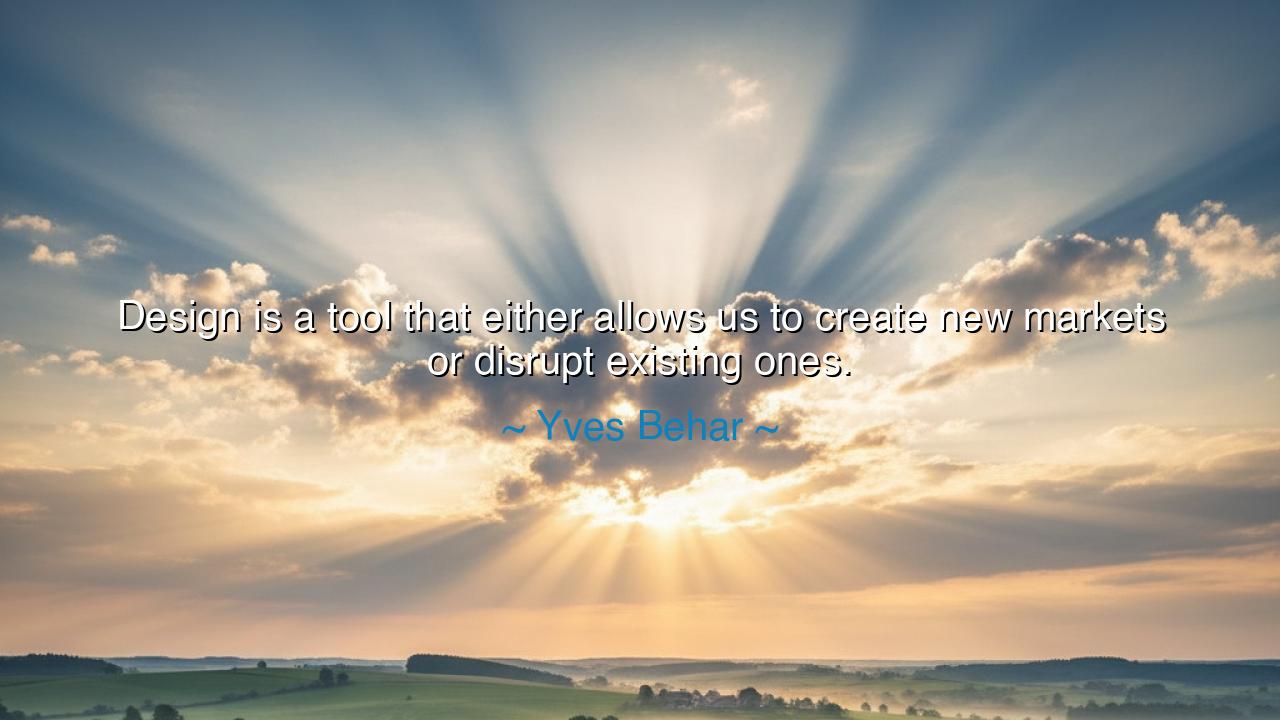
Design is a tool that either allows us to create new markets or






“Design is a tool that either allows us to create new markets or disrupt existing ones.” Thus spoke Yves Béhar, a visionary who stands at the crossroads of art, innovation, and purpose. In this declaration, Béhar unveils a truth that is both ancient and timeless: that design is not mere decoration or ornament, but a force of transformation, capable of reshaping the very structures of human life. His words remind us that design is both a weapon and a seed—a means to break apart the old and to bring forth the new.
When Béhar speaks of design as a tool, he honors its dual nature. Tools are not born for idleness; they are extensions of human will, instruments of change. Just as the plow turned soil into civilization and the compass guided ships into new worlds, so too does design transform imagination into reality. Every age has wielded this tool in its own way. In the age of stone, design meant survival; in the age of steel, it meant progress. Now, in the age of ideas, it means disruption—the power to reimagine the world itself. Béhar’s insight reminds us that creation and destruction are not enemies, but partners in evolution.
To create new markets is to open unseen pathways—to bring forth something the world did not know it needed until it appeared. This is the kind of design that births revolutions quietly, like the first spark that kindles a flame. Think of Steve Jobs and Jony Ive, who designed not merely devices but experiences—the iPhone, the iPad, the ecosystem of modern digital life. Before their work, the market for such things did not exist. After it, the world could not imagine life without them. That is the power of design as creation—to look into the void and see not emptiness, but possibility.
Yet Béhar speaks also of disruption, the other edge of the blade. To disrupt existing markets is to challenge the mighty, to shatter the complacency of what has long been taken for granted. Such disruption is not destruction for its own sake, but renewal born of courage. Consider Elon Musk, whose designs in electric cars and reusable rockets tore through industries thought unassailable. The giants of old mocked him; now they follow him. His designs did not merely improve upon what was—they redefined the rules by which the game was played. This is the holy fire of design that Béhar describes: the power to unmake so that something greater may emerge.
In truth, Béhar’s vision is both philosophical and moral. He reminds us that design carries responsibility, for every act of creation shapes the destiny of others. The designer is not merely a maker of things but a maker of change. When design serves greed, it exploits; when it serves wisdom, it uplifts. The tool in the hand of the fool becomes a weapon of harm; the same tool in the hand of the enlightened becomes an instrument of progress. Thus, the act of design must always begin with intention—a clear understanding of what kind of world one seeks to bring forth.
Throughout history, this truth has echoed. When Leonardo da Vinci designed his machines of flight, he dreamed not of profit, but of liberation—from gravity, from limitation, from the boundaries of imagination. His sketches, centuries ahead of their time, were acts of faith in human potential. Likewise, Béhar teaches that the modern designer must dream boldly but think ethically. The question is not only, Can we design this? but also, Should we? For every disruption must serve life, not diminish it.
So, my listener, take this teaching to heart: to design is to wield power, and power must be guided by vision. Whatever field you work in—art, technology, education, or leadership—treat your ideas as tools of creation and disruption. Ask yourself: What old pattern needs to be broken? What new possibility waits to be born? Do not fear to challenge the old ways, but do so with wisdom and compassion. For only through such balance can design fulfill its highest purpose: not merely to change markets, but to change humanity itself.
Thus, remember the wisdom of Yves Béhar: that design is not passive decoration but active transformation. It is the art of shaping the future. In your hands, it can build worlds, revive dreams, and awaken progress where stagnation has taken root. Use it not only to innovate, but to illuminate—to create with courage, to disrupt with purpose, and to leave behind not just products, but a legacy of vision that endures beyond your own time.






AAdministratorAdministrator
Welcome, honored guests. Please leave a comment, we will respond soon